2011 Oregon Star Party Telescope Walkabout
Variety rules - OSP an effective deadline.
The telescopes on the walkabout represent a variety of designs, several being completed just in nick of time for the star party.
Greg
Babcock's 20 inch f/3.5 all aluminum construction altazimuth telescope
was built by Greg and Nate Courrier. One of the most interesting
aspects of the design is the bridge that stabilizes the focuser board
to a truss tube. The upper ring is designed to act as one of the
baffles. The T-6061 aluminum parts were cut by a waterjet. The scope
weights 115
pounds. The 65 pound mirror box slides out on a track, the mirror being
1 5/8 inch thick Pyrex made by Steve Swayze and supported by a 18 point
flotation. The scope does not require a ladder to view at the
zenith.The scope moves on ball bearings equipped with brakes to stiffen
the motion. Greg always uses the new TeleVue P2 coma corrector while
viewing.Greg plans on minor modifications for the future,.
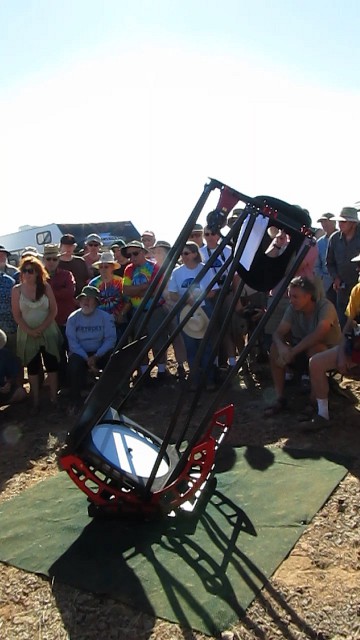

Ian
Morrison's 12.5 inch altazimuth is a single pole design, based on some
of Ross Sackett's ideas. Ian found that the upper ring was too light so
he replaced some of the Oak bottom components with lightened plywood.
The upper ring is very light - just 1.5 pounds! Ian bent the aluminum
for the upper ring one inch at a time then annealed the ring. The wire
spider is made from stainless steel fishing line. He uses a 1.25 inch
focuser to save weight. An old-fashioned hat box holds the upper ring
for transport. The single arm is aluminum tubing which does not ring
and dampens easily by touching it. He may upgrade the azimuth bearing
by replacing the material that the Teflon glides on. The homemade
mirror cell uses rare earth magnets to hold the cover. Mark Cowen of
Obsidian Optics made the Quartz mirror of 6 pounds weight. Total weight
is 30 pounds. Ian uses the encoders with an iPhone app for telescope
positioning.
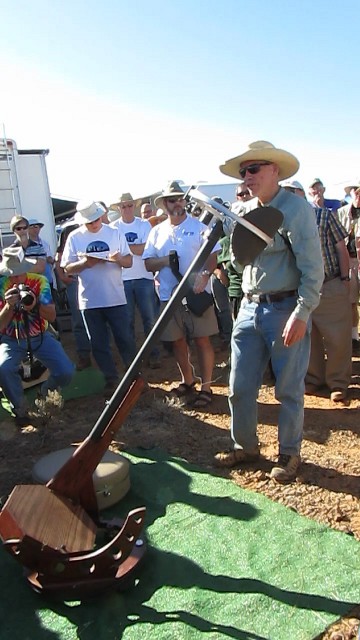

Serge Taran's 18 inch f/4.2 ultra compact
altazimuth fits into a small hatchback car using fold up altitude rims,
collapsing truss tubes that interconnect as a single unit and a carbon
fiber upper end. The mirror is by Zambuto, supported by a sling with
guides and the drive system is by ServoCat and Argo Navis. The scope
has no welding: everything is bolted together. There's an aluminum
spider. The initial upper ring wobbled a bit and he has ideas on
improving the trusses such as making them from carbon fiber. The scope
is shrouded, the zippered shrould being made by his girl friend, Mary.
The overall weight is 75 pounds.This is Serge's first scope and he is
taking it one step at a time.

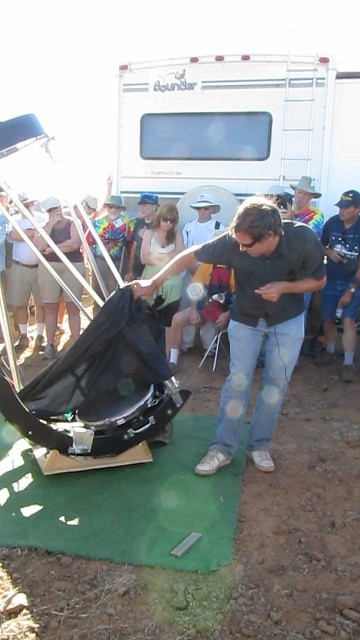
Serge's images are located at http://www.pbase.com/staran/osp2011
Dan Gray's direct drive motor on
his 14 inch scope uses no gears, no rollers and no reducers of any
kind. In fact it has no moving parts. It's home made including the
winding of the copper coils. The magnets are powerful rare earth types.
The encoder feedback is a Renashaw optical encoder attached to the face
of the azimuth ring. The drive system tracks at sub-arc second
accuracy and can slew at 50 degrees per second, whipping the scope
around in a frenzy. Leaning on the scope causes the drive system to
recenter the scope quickly. Thus the drive system can compensate for
wind gusts. Dan made an outstanding movie of comet Garradd the previous
night using his drive system. His scope is fully motorized including
the focuser and de-rotator. The altitude drive is more traditional
roller based drive with a Gurley 320k encoder. The scope overall draws
less power than the laptop that runs the software.


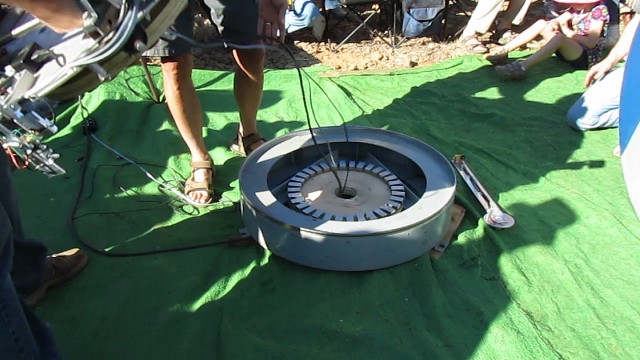
Jerry
Oltien's super sized Astroscan is a ball scope with a tracking system.
The scope is equipped with a 8 inch f/4/2 mirror that Jerry ground and
figured. The ball is a rather unusual 20 inch diameter polycarbonate
intended for pole lighting. He reinforced the ball with fiberglass laid
internally, as opposed to externally covering the ball. The top
cylinder is a garbage can that disconnects from the ball, the focuser
from molded plastic with matching dust cap where the only difference is
that it reads Jerry's name instead of Edmund. There is no optical
window as in the original Astroscan so Jerry uses a curved spider to
make the diffraction spikes invisible.Jerry uses a novel collimation
tool inserted from the topside of the tube. Even the homemade eyepiece
matches the design of the original Edmund Scientific RKE eyepieces. The
scope gives outstanding views and tracks to boot, using a homemade very
simple and inexpensive drive system. To use the scope, one points it at
the object, orients the eyepiece to a comfortable angle and lets go of
the telescope. The scope will track on the object all night long. The
drive consists of two rollers and a motorized axle.

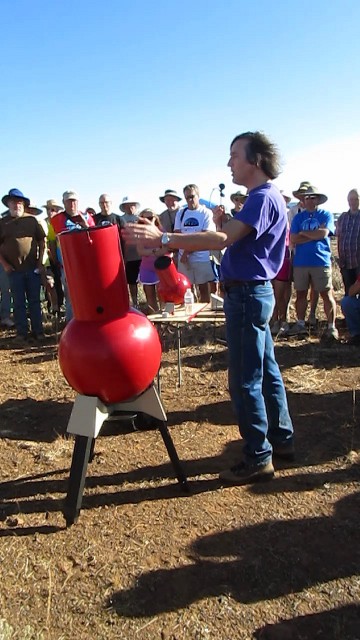
eod









